Research Status of Stability in Dynamic Process of Laser-Arc Hybrid Welding Based on Droplet Transfer Behavior: A Review
Abstract
1. Introduction
2. The Laser-Arc Hybrid Welding Theory
3. Droplet Transfer Mode
3.1. Short-Circuit Transfer
3.2. Globular Transfer
3.3. Spray Transfer
4. Analysis of Droplet Force
4.1. Gravity
4.2. Electromagnetic Force
4.3. Plasma Flow Force
4.4. Surface Tension
4.5. Metal Vapor Reaction Force
5. The Characteristic of Droplet Transfer Behavior
5.1. The Laser-to-Arc Distance
| No. | Influence Aspects | Laser Power | Author | Year/Ref. |
|---|---|---|---|---|
| 1 | Penetration depth | 0.4 kW | Song | 2006/[53] |
| 0.4 kW | Liu | 2012/[54] | ||
| 2 | Process stability | 3.5–5.5 kW | M. Moradi | 2013/[57] |
| 5–8 kW | Atabaki | 2018/[58] | ||
| 4 kW | L. Liu | 2018/[59] | ||
| 2 kW | S. Liu | 2012/[49] | ||
| 5 kW | S. Zhang | 2020/[60] | ||
| 3 | Transfer mode and frequency | 4 kW | W. Liu | 2014/[29] |
| 3 kW | G. Campana | 2007/[61] | ||
| 2 kW | S. Liu | 2011/[49] | ||
| 2 kW | H. Huang | 2021/[62] | ||
| ≥8 kW | J. Zhou | 2008/[41] |

5.2. The Heat Source Leading Mode
5.3. The Shielding Gas Composition
| Shielding Gas Type | Advantages | Year/Ref. |
|---|---|---|
| Ar + 30% He | best transfer behavior and welding process stability | 2021/[80] |
| 40% Ar, 57% He, and 3% O2 | achieving better spray transfer mode | 2007/[61] |
| 20% CO2 + Ar and 100% CO2 | reducing spatters | 2016/[82] |
| CO2 content | enhancing synergistic effect of laser and arc | 2019/[83] |
| 50% He | reducing pore defects | 2018/[84] |
| O2 + Ar mixture gas | increasing penetration depth | 2006/[85] |
| He-Ar mixture gas | achieving full penetration depth | 2006/[65] |
| Type of Gas | Content in the Air/% | Boiling Point at 1.013 × 105 Pa/℃ | Density at 15℃, 1 × 105 Pa/(kg/m3) | Atomic Weight and Mean Molecular Weight Reps | Chemical Activity |
|---|---|---|---|---|---|
| Ar | 0.934 | −185.9 | 1.669 | 39.948 | Inert |
| He | 5.2 × 10−6 | −268.9 | 0.167 | 4.002 | Inert |
| H2 | 0.5 × 10−6 | −252.9 | 0.085 | 2.016 | Reducing |
| O2 | 20.946 | −183.0 | 1.337 | 31.998 | Oxidizing |
| CO2 | 0.033 | −78.5 | 1.849 | 44.011 | Oxidizing |
5.4. The Laser Power
5.4.1. The Addition of Laser
5.4.2. The Effect of Laser Power
6. Conclusions and Future Outlooks
6.1. Conclusions
- (1)
- Distance between laser-to-arc: The DLA affects the mutual coupling effect of the heat sources, thus affecting the weld penetration depth, welding stability, droplet transfer mode, and droplet transfer frequency. It is observed that the best DLA can make the droplet transfer mode more stable, improving the weld formation to a greater extent.
- (2)
- Heat source leading mode: The different relative positions of the laser and arc have a momentous impact on the surface formation and internal performance of the weld. The arrangement of heat sources has a great influence on the absorption efficiency of the laser, and exerts an effect on the dynamic behavior of the droplet, the behavior of the molten pool, and the temperature field. Whether one uses laser-leading mode or arc-leading mode plays a vital role on the droplet transfer and transfer frequency in hybrid welding.
- (3)
- Shielding gas composition: Whether in single laser welding or single arc welding, the shielding gas should be considered. The shielding gas can eliminate the plasma shielding effect effectively and enhance the welding process stability. The interaction of different compositions of shielding gas greatly affects the droplet transfer behavior and transfer frequency.
- (4)
- Laser power: The addition of laser can increase the stability of the arc. When the laser acts on the arc burning stage, the arc is attracted and compressed to the laser focal point, increasing the penetration ability of the laser. Under different conditions, laser can both promote and hinder droplet transfer. The laser energy affects the arc morphology and the heat conduction of the arc plasma, affects the electron density and current density, and changes arc length, droplet size, and speed. With the increase in laser power, the metal vapor reaction force is enhanced, and metal droplet transfer is hindered, which leads to an unstable welding process. The stability of droplet transfer can be improved by adjusting laser energy to coordinate the arc current and voltage.
6.2. Future Outlooks
- (1)
- With the continuous development of engineering machinery, the thickness of plates is also increasing. To meet the stability of thick plate welding, processing grooves for thick plates is indispensable. Due to the complexity of thick plate grooves, arc stability in the welding process is also damaged to a certain extent, resulting in the generation of welding defects. At the same time, the generation of defects has close connection with droplet transfer, and the droplet transfer behavior in thick plate welding is also facing severe problems.
- (2)
- In high-power hybrid welding, the generation of spatter defect is inevitable. The optimization and progress of numerical simulation technology, which breaks through the limitation of defect detection methods, provides a firm academic basis for the further progress of innovative processes.
- (3)
- Due to plenty of process parameters in LAHW, for the sake of obtaining the best weld formation, the window of process parameters is constantly narrowed, and the change in process parameters also exerts a huge effect on droplet transfer characteristics. Therefore, the continuous exploration of process parameters is of great significance for the breakthrough in the field of droplet transfer behavior in LAHW.
Author Contributions
Funding
Institutional Review Board Statement
Informed Consent Statement
Data Availability Statement
Conflicts of Interest
Abbreviations
| projected area of the droplet | LTT | low transformation temperature | |
| ALHW | arc–laser hybrid welding | MAG | metal-active gas welding |
| CMT | cold metal transfer | MIG | metal-inert gas welding |
| Cd | plasma flow coefficient | welding wire radius | |
| DLA | laser-to-arc distance | droplet radius | |
| gravity | TBW | temper bead welding | |
| electromagnetic force | TIG | tungsten inert gas | |
| plasma flow force | plasma velocity | ||
| surface tension | metal stream eruption speed | ||
| metal vapor reaction force | YAG | yttrium aluminum garnet | |
| acceleration of gravity | surface tension coefficient | ||
| welding current | droplet density | ||
| GMAW | gas metal arc welding | plasma density | |
| LAHW | laser–arc hybrid welding | metal vapor density | |
| arc root angle | magnetic conductivity coefficient |
References
- Caccese, V.; Blomquist, P.A.; Berube, K.A.; Webber, S.R.; Orozco, N.J. Effect of weld geometric profile on fatigue life of cruciform welds made by laser/GMAW processes. Mar. Struct. 2006, 19, 1–22. [Google Scholar] [CrossRef]
- Mazar Atabaki, M.; Nikodinovski, M.; Chenier, P.; Ma, J.; Liu, W.; Kovacevic, R. Experimental and numerical investigations of hybrid laser arc welding of aluminum alloys in the thick T-joint configuration. Opt. Laser Technol. 2014, 59, 68–92. [Google Scholar] [CrossRef]
- Shenghai, Z.; Yifu, S.; Huijuan, Q. The technology and welding joint properties of hybrid laser-tig welding on thick plate. Opt. Laser Technol. 2013, 48, 381–388. [Google Scholar] [CrossRef]
- Kurzynowski, T.; Gruber, K.; Stopyra, W.; Kuźnicka, B.; Chlebus, E. Correlation between process parameters, microstructure and properties of 316 L stainless steel processed by selective laser melting. Mater. Sci. Eng. A 2018, 718, 64–73. [Google Scholar] [CrossRef]
- Ascari, A.; Fortunato, A.; Orazi, L.; Campana, G. The influence of process parameters on porosity formation in hybrid LASER-GMA welding of AA6082 aluminum alloy. Opt. Laser Technol. 2012, 44, 1485–1490. [Google Scholar] [CrossRef]
- Wang, J.Y.; Qi, T.; Zhong, C.L.; Zhang, H.; Li, X.R.; Liu, F.D. Study on seam nitrogen behavior of high nitrogen steel hybrid welding. Optik 2021, 242, 167026. [Google Scholar] [CrossRef]
- Heimbs, S.; Engström, H.; Nilsson, K.; Kaplan, A.F.H. Parameter Influence in CO2-Laser/MIG Hybrid Welding. In Proceedings of the Annual Assembly of International Institute of Welding, Stockholm, Sweden, 7 June–7 October 2003. [Google Scholar]
- Steen, W.M. Arc augmented laser processing of materials. J. Appl. Phys. 1980, 51, 5636–5641. [Google Scholar] [CrossRef]
- Campana, G.; Ascari, A.; Fortunato, A.; Tani, G. Hybrid laser-MIG welding of aluminum alloys: The influence of shielding gases. Appl. Surf. Sci. 2009, 255, 5588–5590. [Google Scholar] [CrossRef]
- Gu, X.; Li, H.; Yang, L.; Gao, Y. Coupling mechanism of laser and arcs of laser-twin-arc hybrid welding and its effect on welding process. Opt. Laser Technol. 2013, 48, 246–253. [Google Scholar] [CrossRef]
- Swanson, P.T.; Page, C.J.; Read, E.; Wu, H.Z. Plasma augmented laser welding of 6 mm steel plate. Sci. Technol. Weld. Join. 2007, 12, 153–160. [Google Scholar] [CrossRef]
- Ishide, T.; Tsubota, S.; Watanabe, M. Latest MIG, TIG Arc-YAG Laser Hybrid Welding Systems for Various Welding Products; SPIE: Bellingham, Wa, USA, 2003. [Google Scholar]
- Qin, G.L.; Lei, Z.; Lin, S.Y. Effects of Nd:YAG laser+pulsed MAG arc hybrid welding parameters on its weld shape. Sci. Technol. Weld. Join. 2007, 12, 79–86. [Google Scholar] [CrossRef]
- Fellman, A.; Kujanpää, V. The effect of shielding gas composition on welding performance and weld properties in hybrid CO2 laser–gas metal arc welding of carbon manganese steel. J. Laser Appl. 2006, 18, 12. [Google Scholar] [CrossRef]
- Gumenyuk, A.; Rethmeier, M. Developments in hybrid laser-arc welding technology. In Handbook of Laser Welding Technologies; Elsevier Inc.: Amsterdam, The Netherlands, 2013; pp. 505–521. [Google Scholar] [CrossRef]
- Petring, D.; Fuhrmann, C. Recent progress and innovative solutions for laser-arc hybrid welding. In Proceedings of the PICALO 2004—1st Pacific International Conference on Applications of Laser and Optics, Melbourne, Australia, 19–21 April 2004; pp. 7–10. [Google Scholar] [CrossRef]
- Mahrle, A.; Beyer, E. Hybrid laser beam welding-Classification, characteristics, and applications. J. Laser Appl. 2006, 18, 169. [Google Scholar] [CrossRef]
- Casalino, G.; Campanelli, S.L.; Ludovico, A.D. Laser-arc hybrid welding of wrought to selective laser molten stainless steel. Int. J. Adv. Manuf. Technol. 2013, 68, 209–216. [Google Scholar] [CrossRef]
- Turichin, G.; Kuznetsov, M.; Tsibulskiy, I.; Firsova, A. Hybrid Laser-Arc Welding of the High-Strength Shipbuilding Steels: Equipment and Technology. Phys. Procedia 2017, 89, 156–163. [Google Scholar] [CrossRef]
- Hayashi, T.; Katayama, S.; Abe, N.; Omori, A. High-power CO2 laser-MIG hybrid welding for increased gap tolerance. Hybrid weldability of thick steel plates with a square groove. Weld. Int. 2004, 18, 692–701. [Google Scholar] [CrossRef]
- Le Guen, E.; Fabbro, R.; Coste, F.; Carin, M.; le Masson, P. Analysis of hybrid laser Nd:YAG-MIG/MAG welding processes. In Proceedings of the ICALEO 2008—27th International Congress on Applications of Lasers and Electro-Optics, Temecula, CA, USA, 20–23 October 2008; pp. 1–5. [Google Scholar] [CrossRef]
- Petring, D. Developments in hybridisation and combined laser beam welding technologies. In Handbook of Laser Welding Technologies; Elsevier Inc.: Amsterdam, The Netherlands, 2013; pp. 478–504. [Google Scholar] [CrossRef]
- Chen, M.; Xu, J.; Xin, L.; Zhao, Z.; Wu, F. Comparative study on interactions between laser and arc plasma during laser-GTA welding and laser-GMA welding. Opt. Lasers Eng. 2016, 85, 1–8. [Google Scholar] [CrossRef]
- Zhou, J.; Tsai, H.L.; Wang, P.C. Hybrid laser-arc welding of aerospace and other materials. In Welding and Joining of Aerospace Materials; Elsevier: Amsterdam, The Netherlands, 2012; pp. 109–141. [Google Scholar] [CrossRef]
- Bunaziv, I.; Akselsen, O.M.; Frostevarg, J.; Kaplan, A.F.H. Laser-arc hybrid welding of thick HSLA steel. J. Mater. Process. Technol. 2018, 259, 75–87. [Google Scholar] [CrossRef]
- Pan, Q.; Mizutani, M.; Kawahito, Y.; Katayama, S. High power disk laser-metal active gas arc hybrid welding of thick high tensile strength steel plates. J. Laser Appl. 2016, 28, 12004. [Google Scholar] [CrossRef]
- Mazar Atabaki, M.; Ma, J.; Yang, G.; Kovacevic, R. Hybrid laser/arc welding of advanced high strength steel in different butt joint configurations. Mater. Des. 2014, 64, 573–587. [Google Scholar] [CrossRef]
- Lahdo, R.; Seffer, O.; Springer, A.; Kaierle, S.; Overmeyer, L. GMA-laser hybrid welding of high-strength fine-grain structural steel with an inductive preheating. Phys. Procedia 2014, 56, 637–645. [Google Scholar] [CrossRef]
- Liu, W.; Ma, J.; Yang, G.; Kovacevic, R. Hybrid laser-arc welding of advanced high-strength steel. J. Mater. Process. Technol. 2014, 214, 2823–2833. [Google Scholar] [CrossRef]
- Le Guen, E.; Fabbro, R.; Carin, M.; Coste, F.; le Masson, P. Analysis of hybrid Nd:Yag laser-MAG arc welding processes. Opt. Laser Technol. 2011, 43, 1155–1166. [Google Scholar] [CrossRef]
- Liu, L.; Chen, M. Interactions between laser and arc plasma during laserarc hybrid welding of magnesium alloy. Opt. Lasers Eng. 2011, 49, 1224–1231. [Google Scholar] [CrossRef]
- Song, G. Hybrid laser-arc welding of magnesium alloys. In Welding and Joining of Magnesium Alloys; Elsevier: Amsterdam, The Netherlands, 2010; pp. 229–253e. [Google Scholar] [CrossRef]
- Wang, H.; Liu, L.; Liu, F. The characterization investigation of laser-arc-adhesive hybrid welding of Mg to Al joint using Ni interlayer. Mater. Des. 2013, 50, 463–466. [Google Scholar] [CrossRef]
- Gao, M.; Tang, H.G.; Chen, X.F.; Zeng, X.Y. High power fiber laser arc hybrid welding of AZ31B magnesium alloy. Mater. Des. 2012, 42, 46–54. [Google Scholar] [CrossRef]
- Song, G.; Yu, J.; Li, T.; Wang, J.; Liu, L. Effect of laser-GTAW hybrid welding heat input on the performance of Mg/Steel butt joint. J. Manuf. Process. 2018, 31, 131–138. [Google Scholar] [CrossRef]
- Bunaziv, I.; Akselsen, O.M.; Salminen, A.; Unt, A. Fiber laser-MIG hybrid welding of 5 mm 5083 aluminum alloy. J. Mater. Process. Technol. 2016, 233, 107–114. [Google Scholar] [CrossRef]
- Rao, Z.H.; Hu, J.; Liao, S.M.; Tsai, H.L. Modeling of the transport phenomena in GMAW using argon-helium mixtures. Part I—The arc. Int. J. Heat Mass Transf. 2010, 53, 5707–5721. [Google Scholar] [CrossRef]
- Rao, Z.H.; Hu, J.; Liao, S.M.; Tsai, H.L. Modeling of the transport phenomena in GMAW using argon-helium mixtures. Part II—The metal. Int. J. Heat Mass Transf. 2010, 53, 5722–5732. [Google Scholar] [CrossRef]
- Zhou, J.; Tsai, H.L. Investigation of mixing and diffusion processes in hybrid spot laser-MIG keyhole welding. J. Phys. D Appl. Phys. 2009, 42, 95502. [Google Scholar] [CrossRef]
- Powell, J.; Lamas, J.; Karlsson, J.; Norman, P.; Kaplan, A.F.H.; Yañez, A. The sensitivity of hybrid laser welding to variations in workpiece position. Phys. Procedia 2011, 12, 188–193. [Google Scholar] [CrossRef]
- Zhou, J.; Tsai, H.L. Modeling of transport phenomena in hybrid laser-MIG keyhole welding. Int. J. Heat Mass Transf. 2008, 51, 4353–4366. [Google Scholar] [CrossRef]
- Hu, J.; Tsai, H.L. Heat and mass transfer in gas metal arc welding. Part II: The metal. Int. J. Heat Mass Transf. 2007, 50, 808–820. [Google Scholar] [CrossRef]
- Hu, J.; Tsai, H.L. Heat and mass transfer in gas metal arc welding. Part I: The arc. Int. J. Heat Mass Transf. 2007, 50, 833–846. [Google Scholar] [CrossRef]
- Chen, Y.B.; Feng, J.C.; Li, L.Q.; Li, Y.; Chang, S. Effects of welding positions on droplet transfer in CO2 laser-MAG hybrid welding. Int. J. Adv. Manuf. Technol. 2013, 68, 1351–1359. [Google Scholar] [CrossRef]
- Wang, G.; Huang, P.; Zhang, Y. Numerical Analysis of Metal Transfer in Gas Metal Arc Welding. Metall. Mater. Trans. B 2003, 34, 345–353. [Google Scholar] [CrossRef]
- Fan, H.G.; Kovacevic, R. Dynamic analysis of globular metal transfer in gas metal arc welding-a comparison of numerical and experimental results. J. Phys. D Appl. Phys. 1998, 31, 2929–2941. [Google Scholar] [CrossRef]
- Wu, C.S.; Chen, M.A.; Li, S.K. Analysis of excited droplet oscillation and detachment in active control of metal transfer. Comput. Mater. Sci. 2004, 31, 147–154. [Google Scholar] [CrossRef]
- Planckaert, J.P.; Djermoune, E.H.; Brie, D.; Briand, F.; Richard, F. Modeling of MIG/MAG welding with experimental validation using an active contour algorithm applied on high speed movies. Appl. Math. Model. 2009, 34, 1004–1020. [Google Scholar] [CrossRef]
- Liu, S.; Liu, F.; Zhang, H.; Shi, Y. Analysis of droplet transfer mode and forming process of weld bead in CO2 laserMAG hybrid welding process. Opt. Laser Technol. 2012, 44, 1019–1025. [Google Scholar] [CrossRef]
- Uddin, E.; Iqbal, U.; Arif, N.; Shah, S.R. Analysis of metal transfer in gas metal arc welding. AIP. Conf. Proc. 2019, 2116, 30019. [Google Scholar] [CrossRef]
- Pires, I.; Quintino, L.; Miranda, R.M. Analysis of the influence of shielding gas mixtures on the gas metal arc welding metal transfer modes and fume formation rate. Mater. Des. 2007, 28, 1623–1631. [Google Scholar] [CrossRef]
- Jokinen, T.; Karhu, M.; Kujanpää, V. Welding of thick austenitic stainless steel using Nd:yttrium–aluminum–garnet laser with filler wire and hybrid process. J. Laser Appl. 2003, 15, 220. [Google Scholar] [CrossRef]
- Song, G.; Liu, L.; Wang, P. Overlap welding of magnesium AZ31B sheets using laser-arc hybrid process. Mater. Sci. Eng. A 2006, 429, 312–319. [Google Scholar] [CrossRef]
- Liu, L.M.; Yuan, S.T.; Li, C.B. Effect of relative location of laser beam and TIG arc in different hybrid welding modes. Sci. Technol. Weld. Join. 2012, 17, 441–446. [Google Scholar] [CrossRef]
- Uchiumi, S.; Wang, J.B.; Katayama, S.; Mizutani, M.; Hongu, T.; Fujii, K. Penetration and welding phenomena in YAG laser-MIG hybrid welding of aluminum alloy. In Proceedings of the ICALEO 2004—23rd International Congress on Applications of Laser and Electro-Optics, San Francisco, CA, USA, 4–7 October 2004. [Google Scholar] [CrossRef]
- Thomy, C. Hybrid laser-arc welding of aluminium. In Hybrid Laser-Arc Welding: A Volume in Woodhead Publishing Series in Welding and Other Joining Technologies; Elsevier Ltd.: Amsterdam, The Netherlands, 2009; pp. 216–269. [Google Scholar] [CrossRef]
- Moradi, M.; Ghoreishi, M.; Frostevarg, J.; Kaplan, A.F.H. An investigation on stability of laser hybrid arc welding. Opt. Lasers Eng. 2013, 51, 481–487. [Google Scholar] [CrossRef]
- Mazar Atabaki, M.; Yazdian, N.; Kovacevic, R. Hybrid laser/arc welding of thick high-strength steel in different configurations. Adv. Manuf. 2018, 6, 176–188. [Google Scholar] [CrossRef]
- Liu, L.; Shi, J.; Hou, Z.; Song, G. Effect of distance between the heat sources on the molten pool stability and burn-through during the pulse laser-GTA hybrid welding process. J. Manuf. Process. 2018, 34, 697–705. [Google Scholar] [CrossRef]
- Zhang, S.; Wang, Y.; Zhu, M.; Feng, Y.; Nie, P.; Li, Z. Effects of heat source arrangements on Laser-MAG hybrid welding characteristics and defect formation mechanism of 10CrNi3MoV steel. J. Manuf. Process. 2020, 58, 563–573. [Google Scholar] [CrossRef]
- Campana, G.; Fortunato, A.; Ascari, A.; Tani, G.; Tomesani, L. The influence of arc transfer mode in hybrid laser-mig welding. J. Mater. Process. Technol. 2007, 191, 111–113. [Google Scholar] [CrossRef]
- Huang, H.; Zhang, P.; Yan, H.; Liu, Z.; Yu, Z.; Wu, D.; Shi, H.; Tian, Y. Research on weld formation mechanism of laser-MIG arc hybrid welding with butt gap. Opt. Laser Technol. 2021, 133, 106530. [Google Scholar] [CrossRef]
- Wang, X.; Huang, Y.; Zhang, Y. Droplet transfer model for laser-enhanced GMAW. Int. J. Adv. Manuf. Technol. 2013, 64, 207–217. [Google Scholar] [CrossRef]
- Shinn, B.W.; Farson, D.F.; Denney, P.E. Laser stabilisation of arc cathode spots in titanium welding. Sci. Technol. Weld. Join. 2005, 10, 475–481. [Google Scholar] [CrossRef]
- Ming, G.; Xiaoyan, Z.; Qianwu, H. Effects of gas shielding parameters on weld penetration of CO2 laser-TIG hybrid welding. J. Mater. Process. Technol. 2007, 184, 177–183. [Google Scholar] [CrossRef]
- Bang, H.S.; Bang, H.S.; Kim, Y.C.; Oh, I.H. A study on mechanical and microstructure characteristics of the STS304L butt joints using hybrid CO2 laser-gas metal arc welding. Mater. Des. 2011, 32, 2328–2333. [Google Scholar] [CrossRef]
- Zhang, Y.; Chen, G.; Zhou, C.; Jiang, Y.; Zhong, P.; Li, S. Pores formation in laser–MAG welding of 42CrMo steel. J. Mater. Process. Technol. 2017, 245, 309–317. [Google Scholar] [CrossRef]
- Casalino, G.; Campanelli, S.L.; Maso, U.D.; Ludovico, A.D. Arc leading versus laser leading in the hybrid welding of aluminium alloy using a fiber laser. Procedia CIRP 2013, 12, 151–156. [Google Scholar] [CrossRef]
- Huang, L.; Wu, D.; Hua, X.; Liu, S.; Jiang, Z.; Li, F.; Wang, H.; Shi, S. Effect of the welding direction on the microstructural characterization in fiber laser-GMAW hybrid welding of 5083 aluminum alloy. J. Manuf. Process. 2018, 31, 514–522. [Google Scholar] [CrossRef]
- Zhang, W.; Hua, X.; Liao, W.; Li, F.; Wang, M. The effect of the welding direction on the plasma and metal transfer behavior of CO2 laser+GMAW-P hybrid welding processes. Opt. Lasers Eng. 2014, 58, 102–108. [Google Scholar] [CrossRef]
- Miao, H.; Yu, G.; He, X.; Li, S.; Chen, X. Comparative study of hybrid laser–MIG leading configuration on porosity in aluminum alloy bead-on-plate welding. Int. J. Adv. Manuf. Technol. 2017, 91, 2681–2688. [Google Scholar] [CrossRef]
- Cao, X.; Wanjara, P.; Huang, J.; Munro, C.; Nolting, A. Hybrid fiber laser—Arc welding of thick section high strength low alloy steel. Mater. Des. 2011, 32, 3399–3413. [Google Scholar] [CrossRef]
- Zhao, L.; Sugino, T.; Arakane, G.; Tsukamoto, S. Influence of welding parameters on distribution of wire feeding elements in CO2 laser GMA hybrid welding. Sci. Technol. Weld. Join. 2009, 14, 457–467. [Google Scholar] [CrossRef]
- Liu, S.; Li, Y.; Liu, F.; Zhang, H.; Ding, H. Effects of relative positioning of energy sources on weld integrity for hybrid laser arc welding. Opt. Lasers Eng. 2016, 81, 87–96. [Google Scholar] [CrossRef]
- Li, Y.; Geng, S.; Zhu, Z.; Wang, Y.; Mi, G.; Jiang, P. Effects of heat source configuration on the welding process and joint formation in ultra-high power laser-MAG hybrid welding. J. Manuf. Process. 2022, 77, 40–53. [Google Scholar] [CrossRef]
- Bunaziv, I.; Frostevarg, J.; Akselsen, O.M.; Kaplan, A.F.H. The penetration efficiency of thick plate laser-arc hybrid welding. Int. J. Adv. Manuf. Technol. 2018, 97, 2907–2919. [Google Scholar] [CrossRef]
- Liu, S.; Liu, F.; Xu, C.; Zhang, H. Experimental investigation on arc characteristic and droplet transfer in CO2 laser-metal arc gas (MAG) hybrid welding. Int. J. Heat Mass Transf. 2013, 62, 604–611. [Google Scholar] [CrossRef]
- Wahba, M.; Mizutani, M.; Katayama, S. Hybrid welding with fiber laser and CO2 gas shielded arc. J. Mater. Process. Technol. 2015, 221, 146–153. [Google Scholar] [CrossRef]
- Kah, P.; Salminen, A.; Martikainen, J. The analysis of shielding gases in laser-arc hybrid welding processes. Proc. Inst. Mech. Eng. Part B J. Eng. Manuf. 2011, 225, 1073–1082. [Google Scholar] [CrossRef]
- Zhu, Y.; Cai, Y.; Wang, M. Effects of He content in shielding gases on high-efficient hybrid laser arc welding with C-276 filler metal. J. Mater. Process. Technol. 2022, 299, 117367. [Google Scholar] [CrossRef]
- Cai, C.; Li, L.; Tai, L. Narrow-gap laser-MIG hybrid welding of thick-section steel with different shielding gas nozzles. Int. J. Adv. Manuf. Technol. 2017, 92, 909–916. [Google Scholar] [CrossRef]
- Pan, Q.; Mizutani, M.; Kawahito, Y.; Katayama, S. Effect of shielding gas on laser–MAG arc hybrid welding results of thick high-tensile-strength steel plates. Weld. World 2016, 60, 653–664. [Google Scholar] [CrossRef]
- Zhang, S.; Sun, J.; Zhu, M.; Zhang, L.; Nie, P.; Li, Z. Effects of shielding gases on process stability of 10CrNi3MoV steel in hybrid laser-arc welding. J. Mater. Process. Technol. 2019, 270, 37–46. [Google Scholar] [CrossRef]
- Cai, C.; He, S.; Chen, H.; Zhang, W. The influences of Ar-He shielding gas mixture on welding characteristics of fiber laser-MIG hybrid welding of aluminum alloy. Opt. Laser Technol. 2019, 113, 37–45. [Google Scholar] [CrossRef]
- Naito, Y.; Mizutani, M.; Katayama, S. Effect of oxygen in ambient atmosphere on penetration characteristics in single yttrium–aluminum–garnet laser and hybrid welding. J. Laser Appl. 2006, 18, 21–27. [Google Scholar] [CrossRef]
- Tani, G.; Campana, G.; Fortunato, A.; Ascari, A. The influence of shielding gas in hybrid LASER-MIG welding. Appl. Surf. Sci. 2007, 253, 8050–8053. [Google Scholar] [CrossRef]
- Tani, G.; Ascari, A.; Campana, G.; Fortunato, A. A study on shielding gas contamination in laser welding of non-ferrous alloys. Appl. Surf. Sci. 2007, 254, 904–907. [Google Scholar] [CrossRef]
- Yang, X.; Chen, H.; Zhu, Z.; Cai, C.; Zhang, C. Effect of shielding gas flow on welding process of laser-arc hybrid welding and MIG welding. J. Manuf. Process. 2019, 38, 530–542. [Google Scholar] [CrossRef]
- Gao, M.; Zeng, X.Y. Effect of shielding gas on hybrid laser-arc welding. In Hybrid Laser-Arc Welding: A Volume in Woodhead Publishing Series in Welding and Other Joining Technologies; Elsevier Ltd.: Amsterdam, The Netherlands, 2009; pp. 85–105. [Google Scholar] [CrossRef]
- Murakami, T.; Nakata, K.; Yamamoto, N.; Liao, J. Formation of one pass fully-Penetrated weld bead of titanium plate by fiber laser and MIG Arc hybrid welding. Mater. Trans. 2012, 53, 1017–1021. [Google Scholar] [CrossRef]
- Sugino, T.; Tsukamoto, S.; Nakamura, T.; Arakane, G. Fundamental study on welding phenomena in pulsed laser-GMA hybrid welding. In Proceedings of the 24th International Congress on Applications of Lasers and Electro-Optics, ICALEO, Miami, FL, USA, 31 October–3 November 2005; pp. 108–116. [Google Scholar] [CrossRef]
- Fellman, A.; Salminen, A. A study of the phenomenon of CO2-laser welding with filler wire and MAG hybrid welding. In Proceedings of the 24th International Congress on Applications of Lasers and Electro-Optics, ICALEO, Miami, FL, USA, 31 October–3 November 2005; pp. 117–126. [Google Scholar] [CrossRef]
- Ono, M.; Shinbo, Y.; Yoshitake, A.; Ohmura, M. Welding Properties of Thin Steel Sheets by Laser-Arc Hybrid Welding-Laser Focused Arc Welding; NKK Corporation 1 Kokan-cho, Japan; SPIE: Bellingham, WA, USA, 2003. [Google Scholar]
- Gao, M.; Mei, S.; Wang, Z.; Li, X.; Zeng, X. Process and joint characterizations of laser-MIG hybrid welding of AZ31 magnesium alloy. J. Mater. Process. Technol. 2012, 212, 1338–1346. [Google Scholar] [CrossRef]
- Zhang, C.; Gao, M.; Zeng, X. Influences of synergy effect between laser and arc on laser-arc hybrid welding of aluminum alloys. Opt. Laser Technol. 2019, 120, 105766. [Google Scholar] [CrossRef]
- Mei, L.; Yan, D.; Yi, J.; Chen, G.; Ge, X. Comparative analysis on overlap welding properties of fiber laser and CO2 laser for body-in-white sheets. Mater. Des. 2013, 49, 905–912. [Google Scholar] [CrossRef]
- Kwon, H.; Baek, W.K.; Kim, M.S.; Shin, W.S.; Yoh, J.J. Temperature-dependent absorptance of painted aluminum, stainless steel 304, and titanium for 1.07 μm and 10.6 μm laser beams. Opt. Lasers Eng. 2012, 50, 114–121. [Google Scholar] [CrossRef]
- Tu, J.F.; Riley, P.E.B. Low-temperature evaporative glass scoring using a single-mode ytterbium fiber laser. Opt. Lasers Eng. 2013, 51, 696–706. [Google Scholar] [CrossRef]
- Sinha, A.K.; Kim, D.Y.; Ceglarek, D. Correlation analysis of the variation of weld seam and tensile strength in laser welding of galvanized steel. Opt. Lasers Eng. 2013, 51, 1143–1152. [Google Scholar] [CrossRef]
- Unt, A.; Lappalainen, E.; Salminen, A. Autogeneous laser and hybrid laser arc welding of T-joint low alloy steel with fiber laser systems. Phys. Procedia 2013, 41, 140–143. [Google Scholar] [CrossRef]
- Lamas, J.; Karlsson, J.; Norman, P.; Powell, J.; Kaplan, A.F.H.; Yañez, A. The effect of fit-up geometry on melt flow and weld quality in laser hybrid welding. J. Laser Appl. 2013, 25, 32010. [Google Scholar] [CrossRef]
- Chen, Y.; Feng, J.; Li, L.; Chang, S.; Ma, G. Microstructure and mechanical properties of a thick-section high-strength steel welded joint by novel double-sided hybrid fibre laser-arc welding. Mater. Sci. Eng. A 2013, 582, 284–293. [Google Scholar] [CrossRef]
- Casalino, G.; Campanelli, S.; Ludovico, A.D. Hybrid welding of AA5754-H111 alloy using a fiber laser. Adv. Mater. Res. 2013, 628, 193–198. [Google Scholar] [CrossRef]
- Cai, C.; Feng, J.; Li, L.; Chen, Y. Influence of laser on the droplet behavior in short-circuiting, globular, and spray modes of hybrid fiber laser-MIG welding. Opt. Laser Technol. 2016, 83, 108–118. [Google Scholar] [CrossRef]
- Huang, A.; Zhang, J.; Gao, C.; Hu, R.; Pang, S. Effects of groove constraint space on plasma characteristics during Laser-MIG hybrid welding of Titanium alloy. J. Manuf. Process. 2019, 48, 137–144. [Google Scholar] [CrossRef]
- Liu, S.; Zhang, F.; Dong, S.; Zhang, H.; Liu, F. Characteristics analysis of droplet transfer in laser-MAG hybrid welding process. Int. J. Heat Mass Transf. 2018, 121, 805–811. [Google Scholar] [CrossRef]
- Zhang, W.; Hua, X.; Liao, W.; Li, F.; Wang, M. Study of metal transfer in CO2 laser+GMAW-P hybrid welding using argon-helium mixtures. Opt. Laser Technol. 2014, 56, 158–166. [Google Scholar] [CrossRef]
- Petring, D.; Fuhrmann, C.; Wolf, N.; Poprawe, R. Investigations and applications of laser-arc hybrid welding from thin sheets up to heavy section components. In Proceedings of the ICALEO 2003—22nd International Congress on Applications of Laser and Electro-Optics, Jacksonville, FL, USA, 13–16 October 2003. [Google Scholar] [CrossRef]
- Chen, M.; Xin, L.; Zhou, Q.; He, L.; Wu, F. Effect of laser pulse on alternative current arc discharge during laser-arc hybrid welding of magnesium alloy. Opt. Lasers Eng. 2018, 100, 208–215. [Google Scholar] [CrossRef]
- Li, F.; Tao, W.; Peng, G.; Qu, J.; Li, L. Behavior and stability of droplet transfer under laser-MIG hybrid welding with synchronized pulse modulations. J. Manuf. Process. 2020, 54, 70–79. [Google Scholar] [CrossRef]
- Lei, Z.; Li, B.; Bi, J.; Zhu, P.; Lu, W.; Liu, J. Influence of the laser thermal effect on the droplet transfer behavior in laser-CMT welding. Opt. Laser Technol. 2019, 120, 105728. [Google Scholar] [CrossRef]
- Zhang, W.; Hua, X.; Liao, W.; Li, F.; Wang, M. Behavior of the plasma characteristic and droplet transfer in CO2 laser-GMAW-P hybrid welding. Int. J. Adv. Manuf. Technol. 2014, 72, 105728. [Google Scholar] [CrossRef]
- Zhang, F.; Liu, S.; Liu, F.; Zhang, H. Stability evaluation of laser-MAG hybrid welding process. Opt. Laser Technol. 2019, 116, 284–292. [Google Scholar] [CrossRef]
- Tomków, J.; Landowski, M.; Fydrych, D.; Rogalski, G. Underwater wet welding of S1300 ultra-high strength steel. Mar. Struct. 2021, 81, 103120. [Google Scholar] [CrossRef]
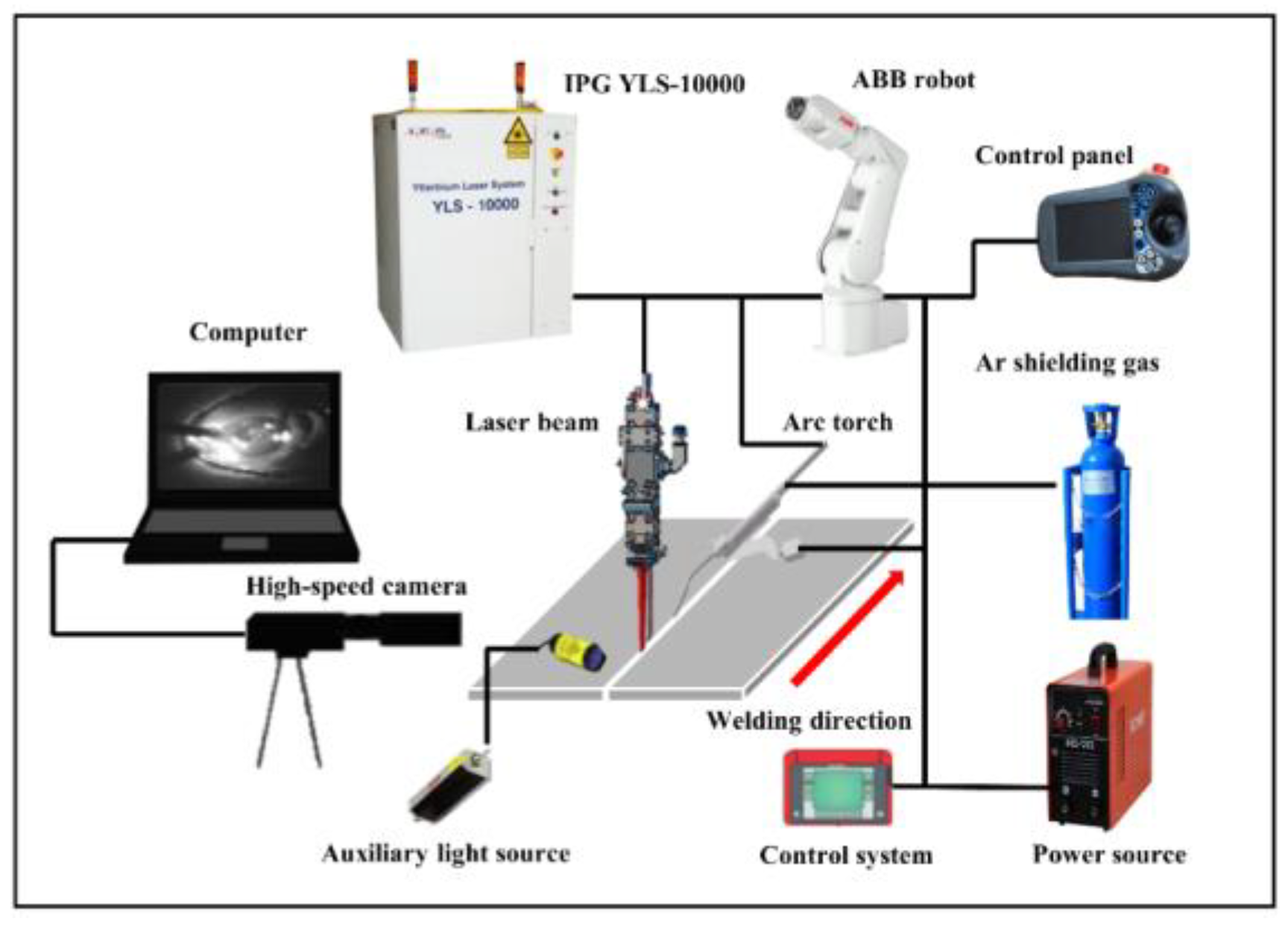
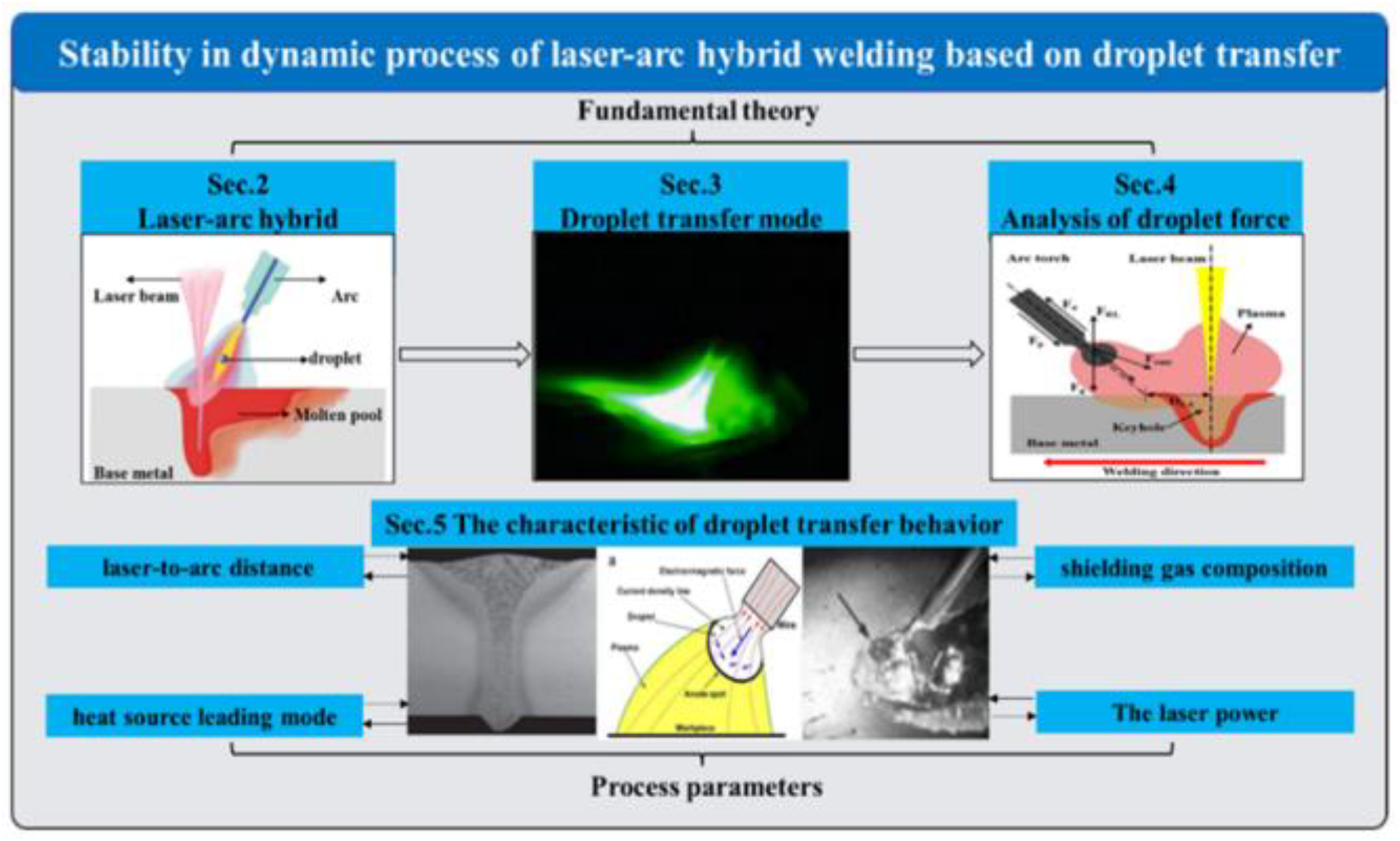


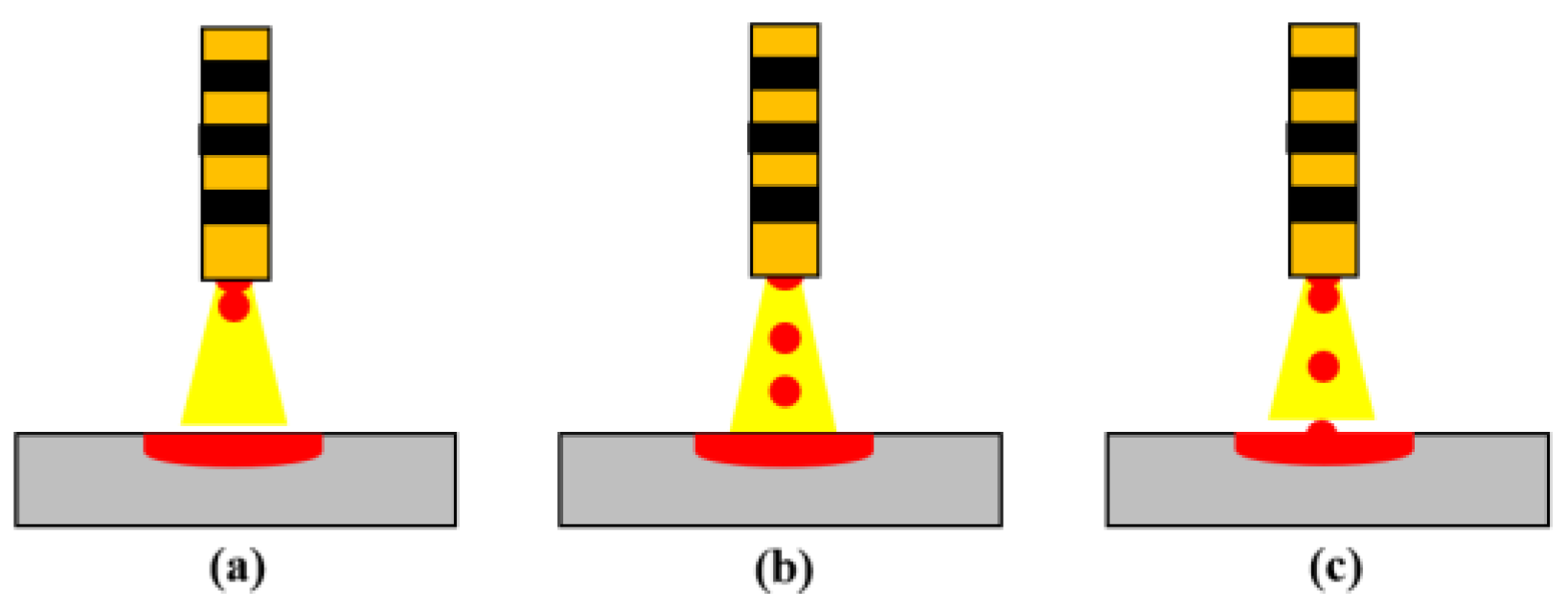

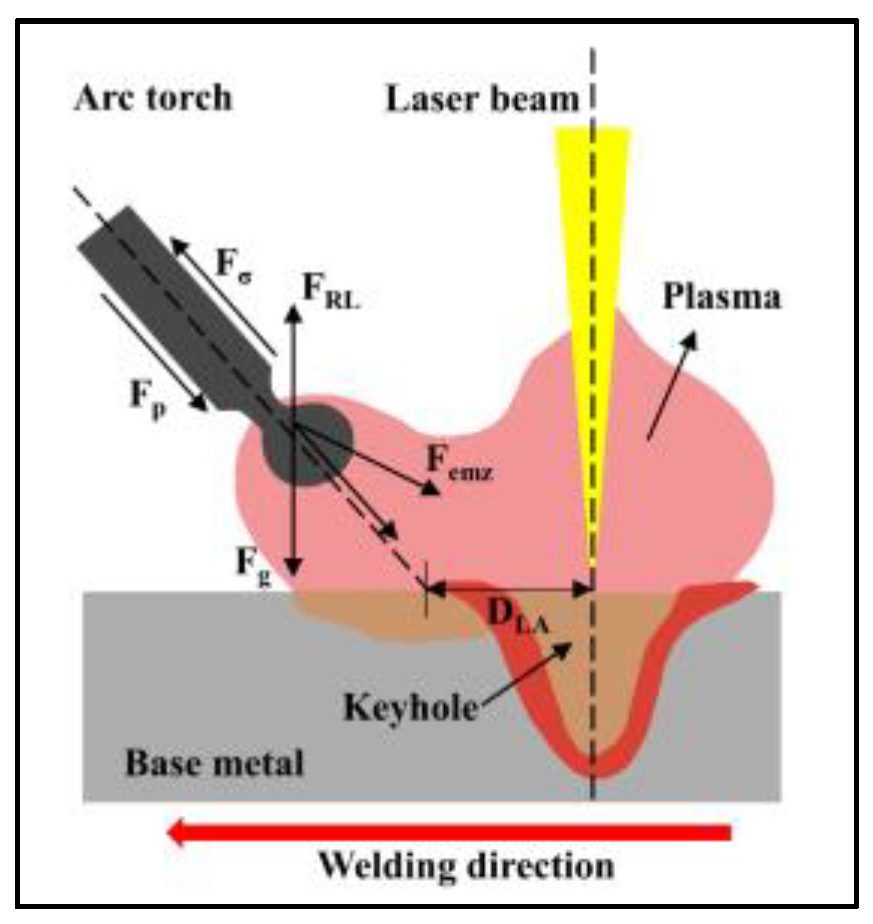
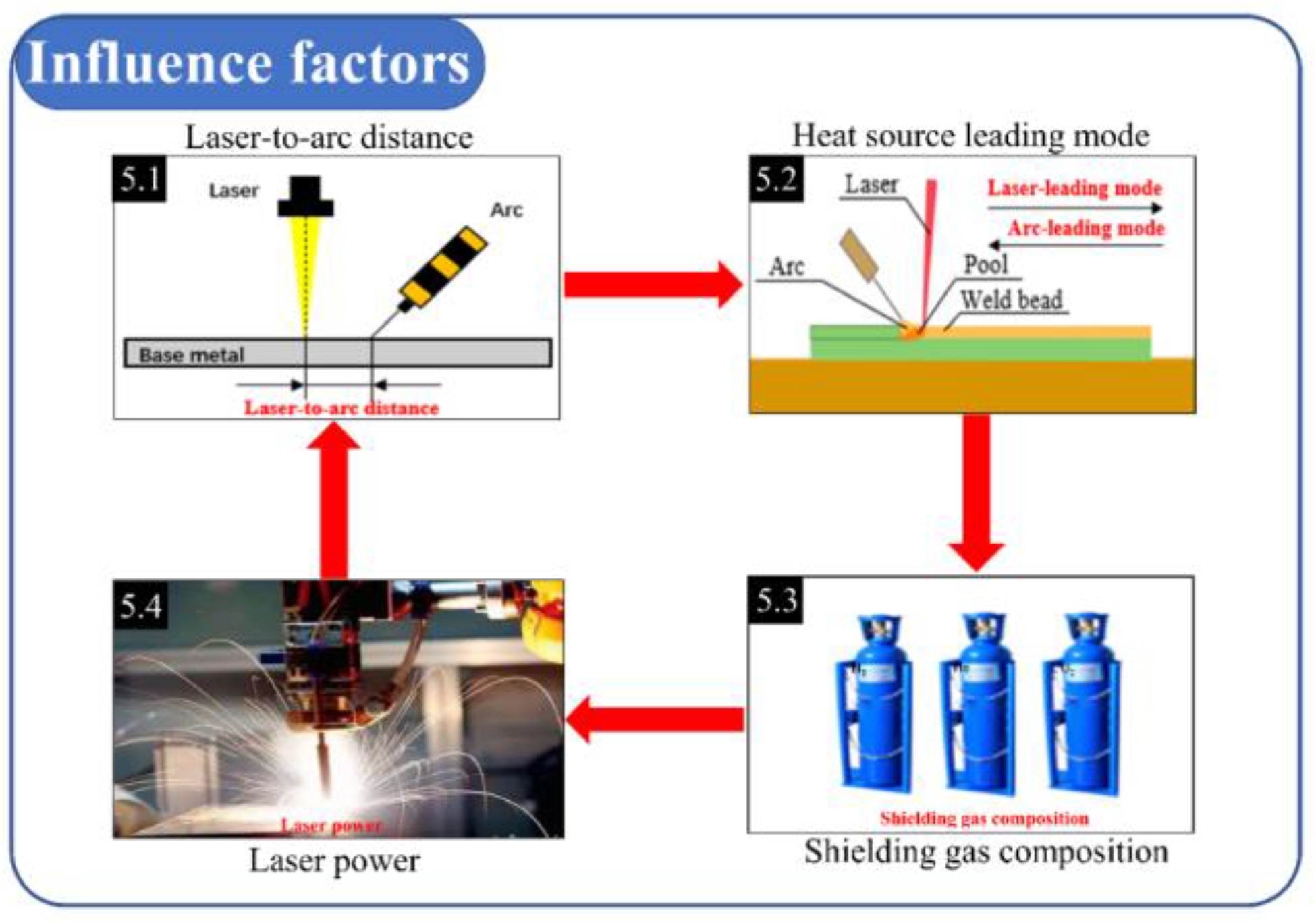
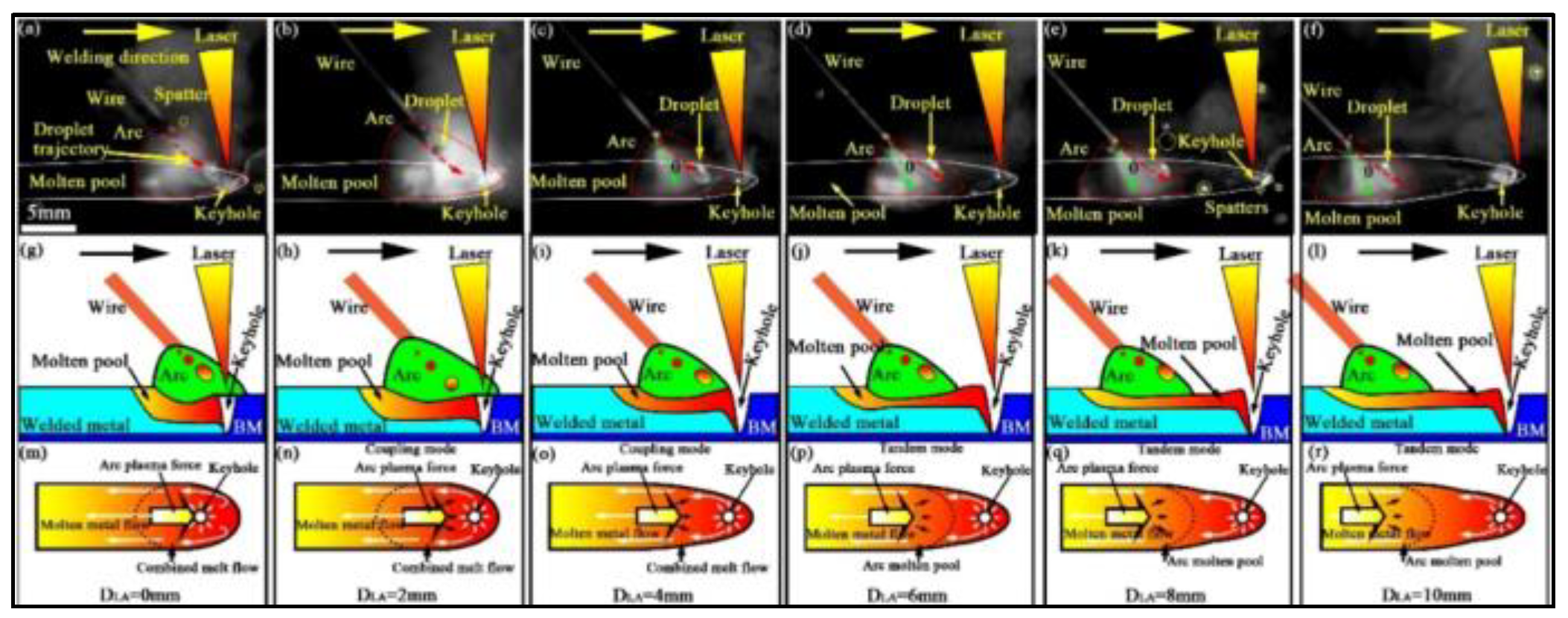





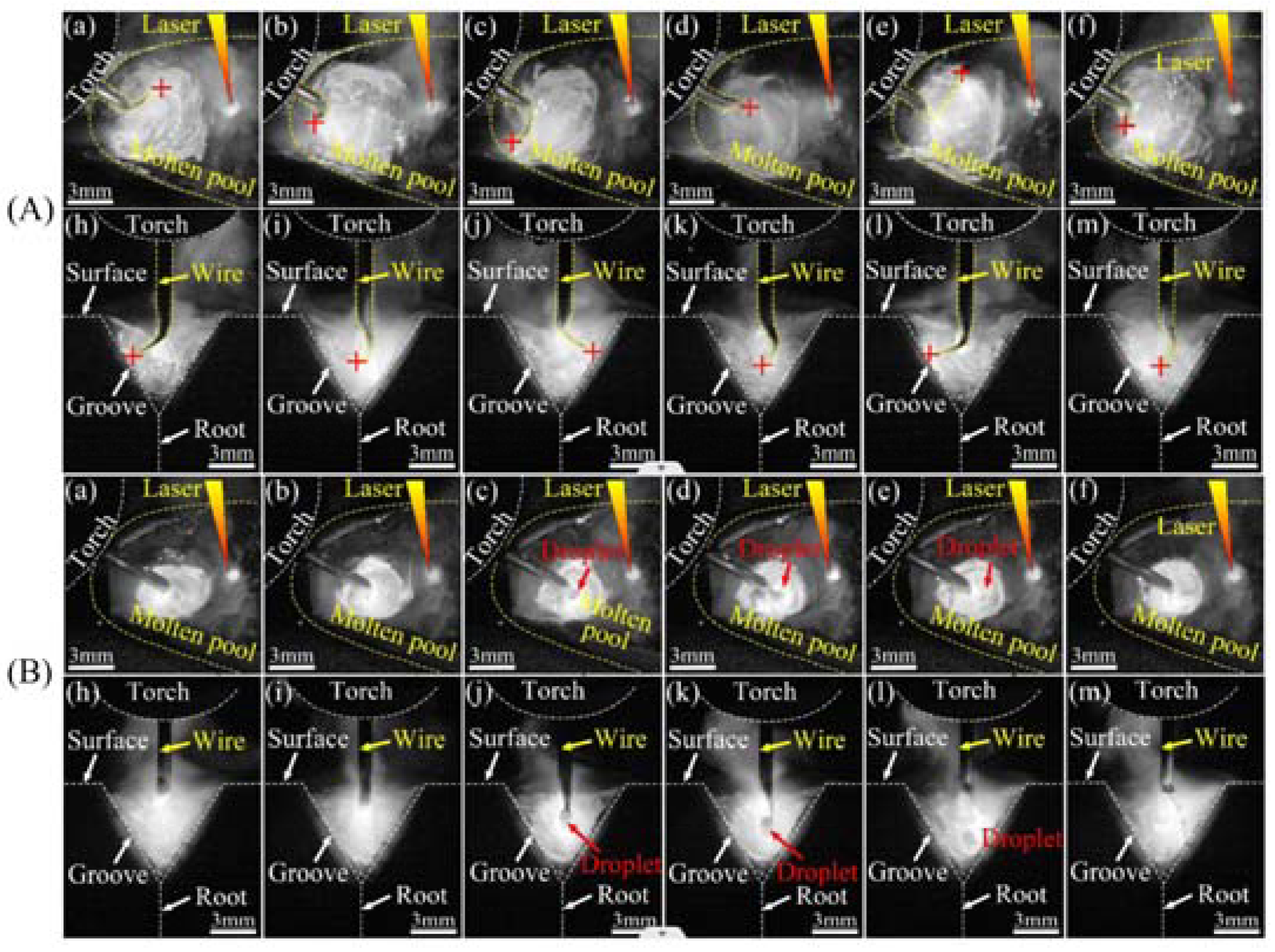
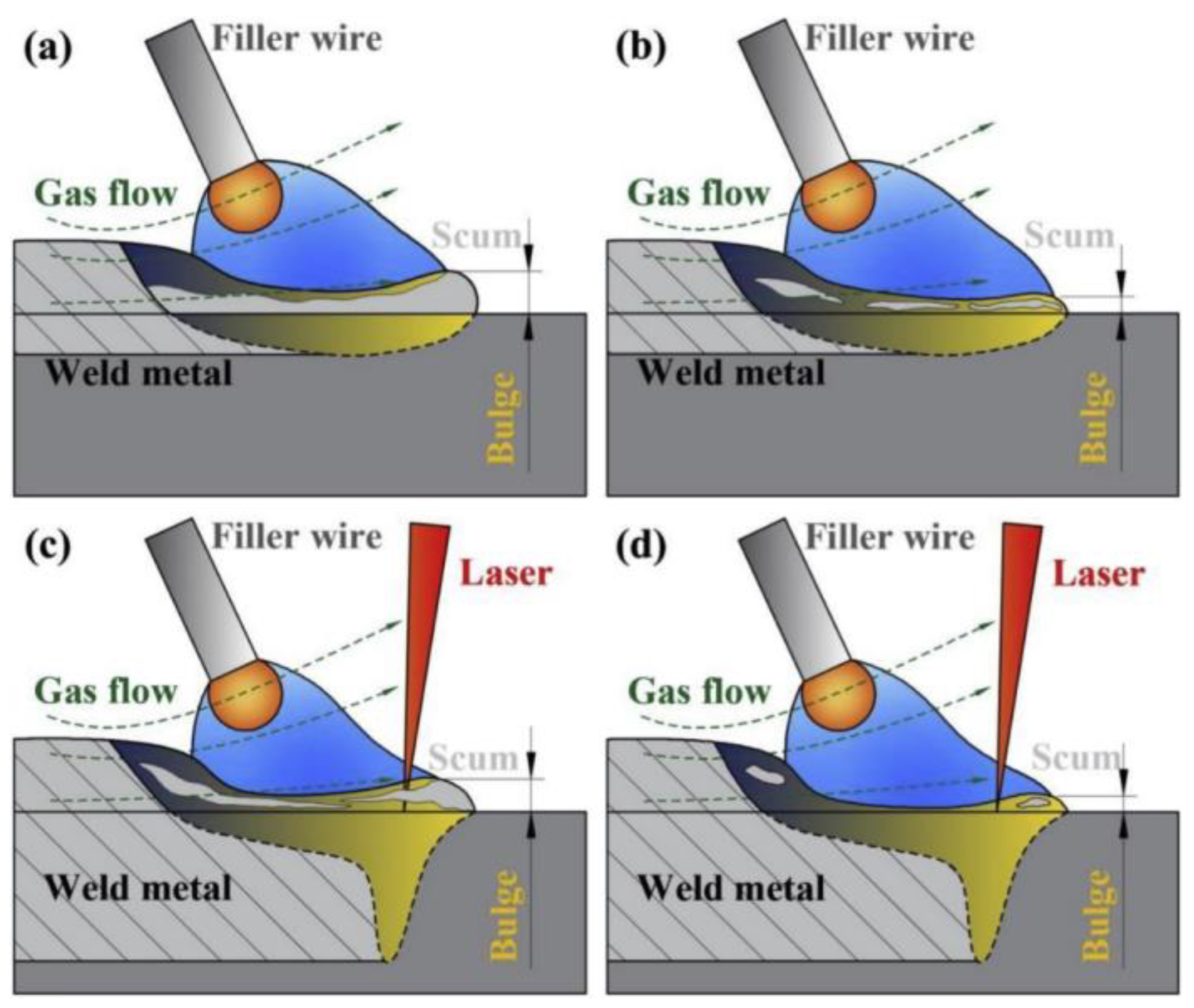
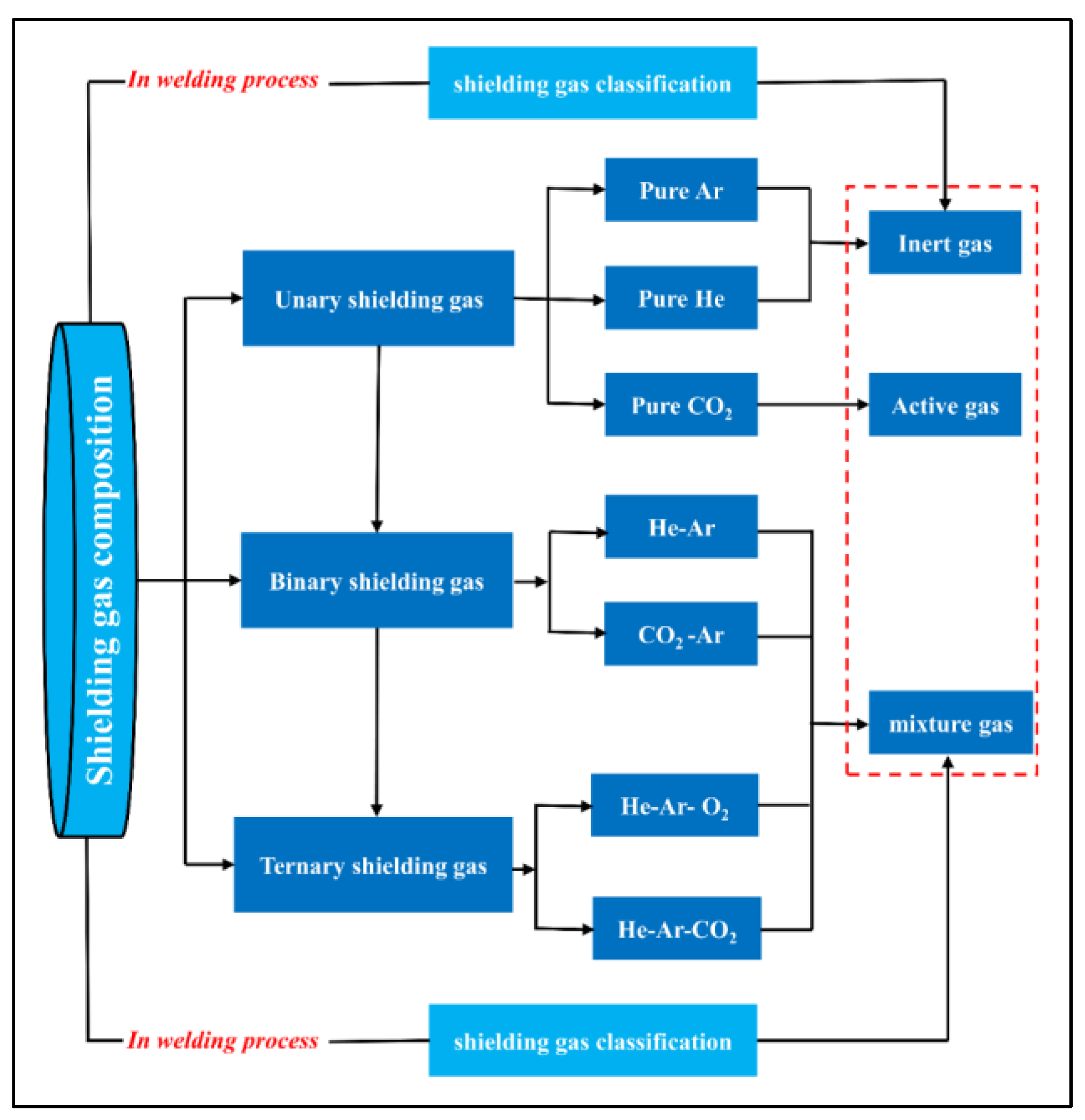
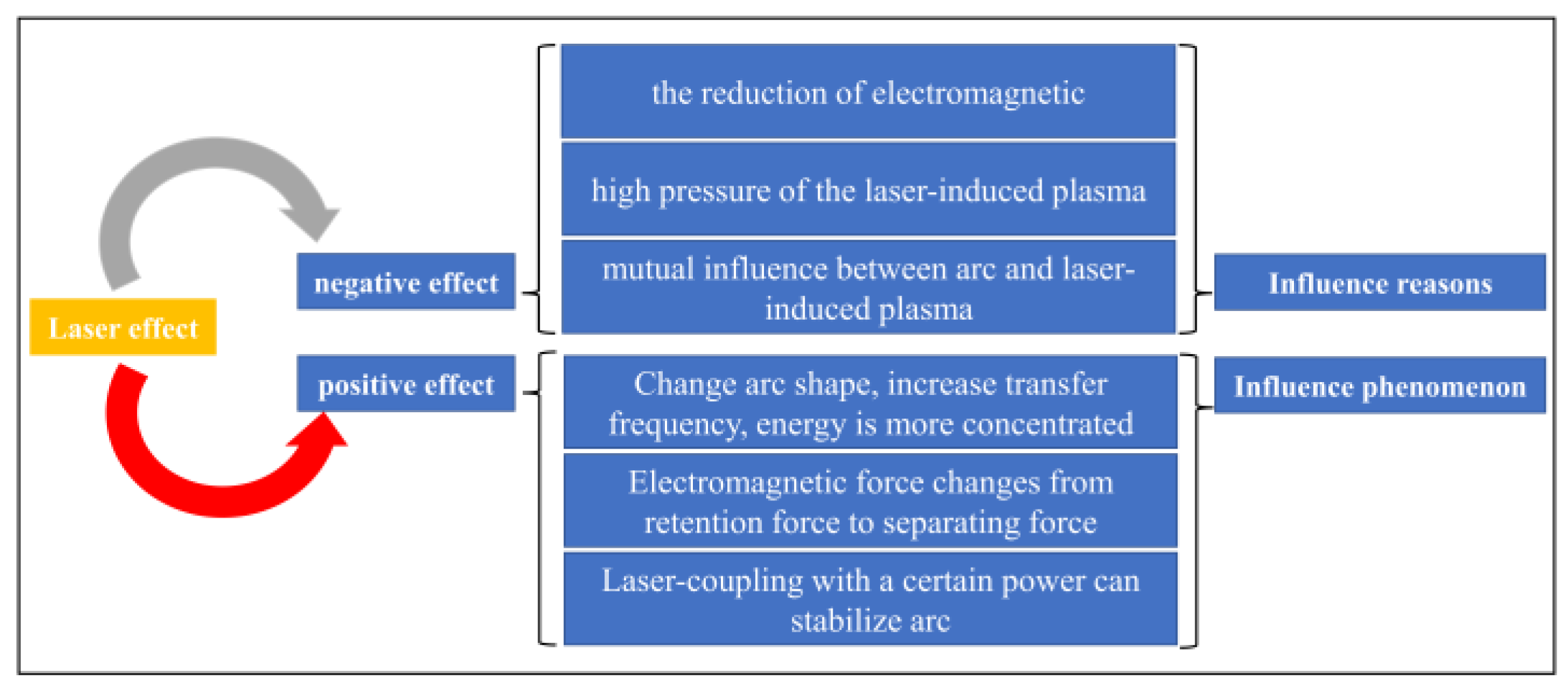
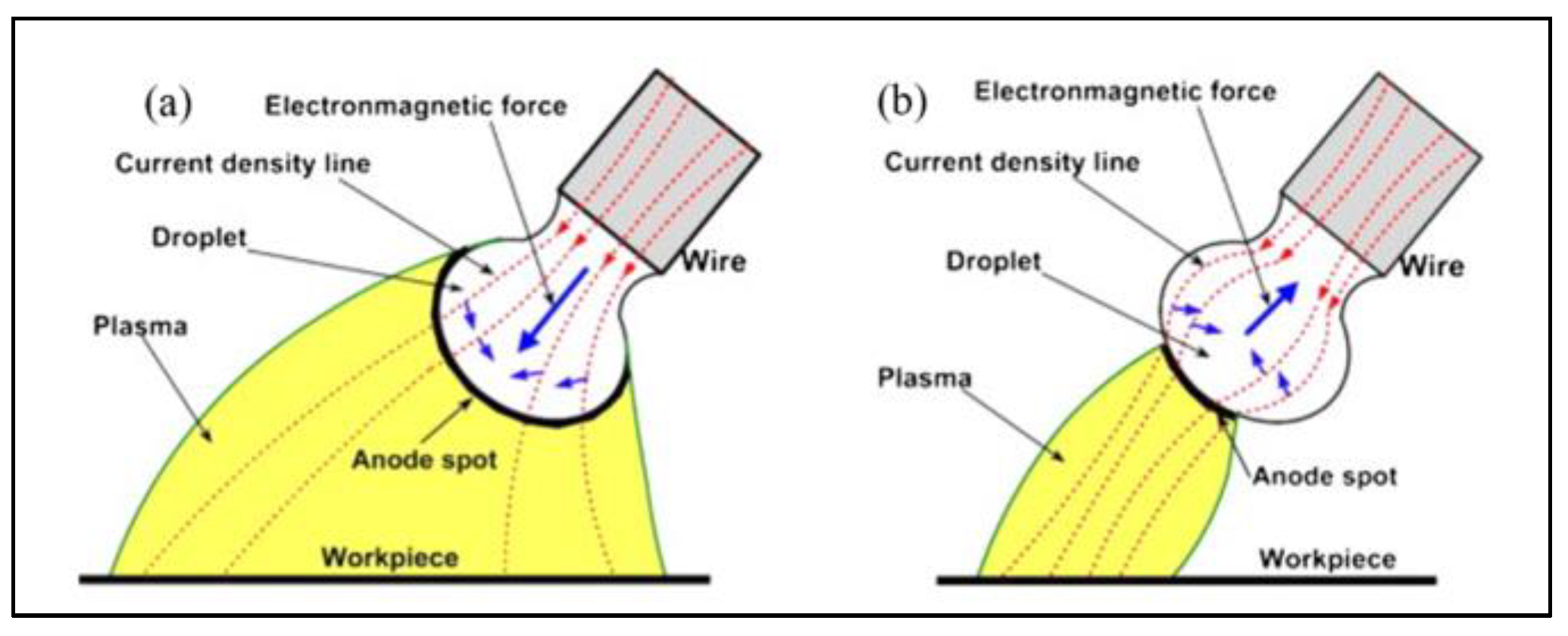
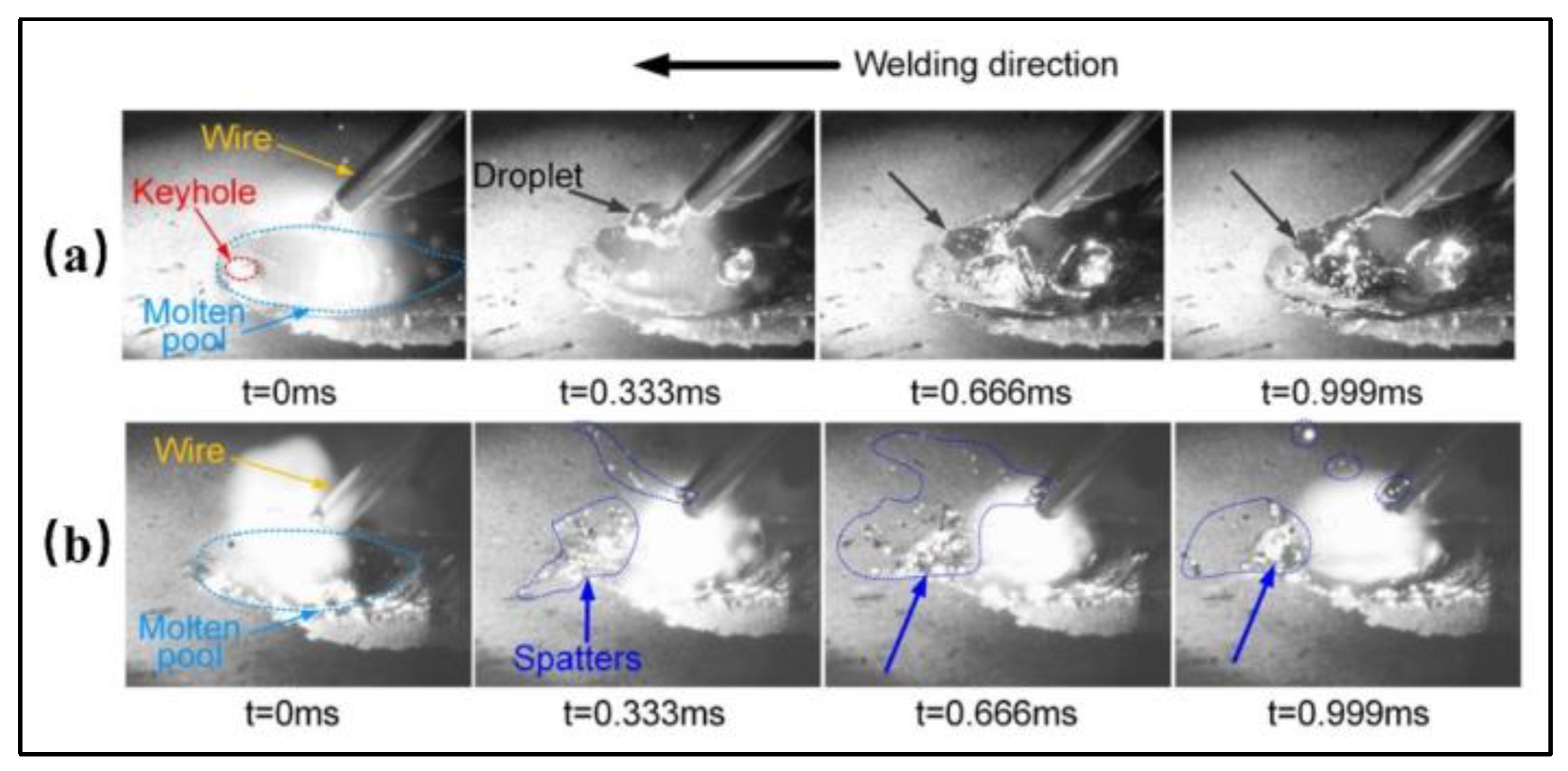
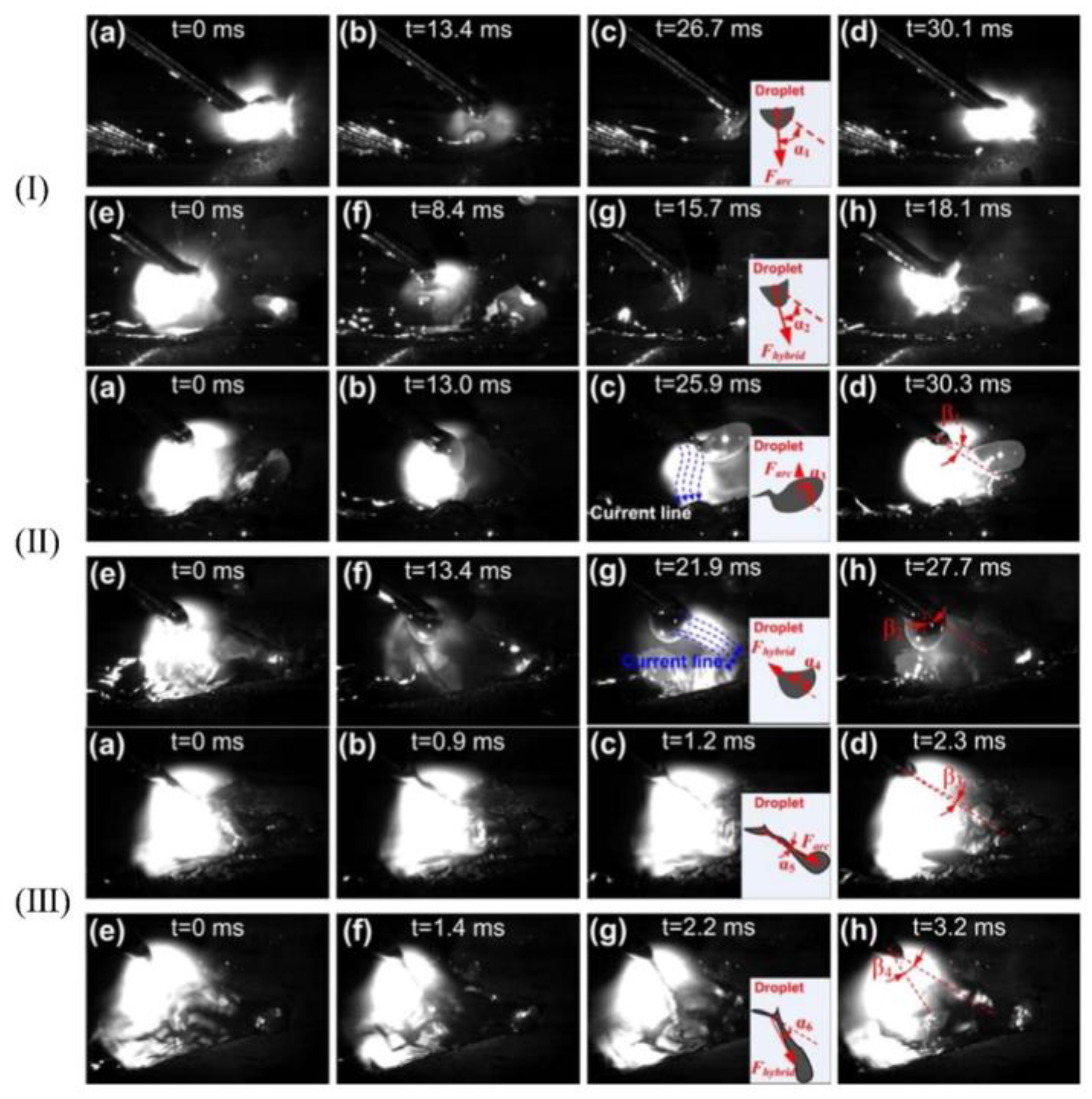
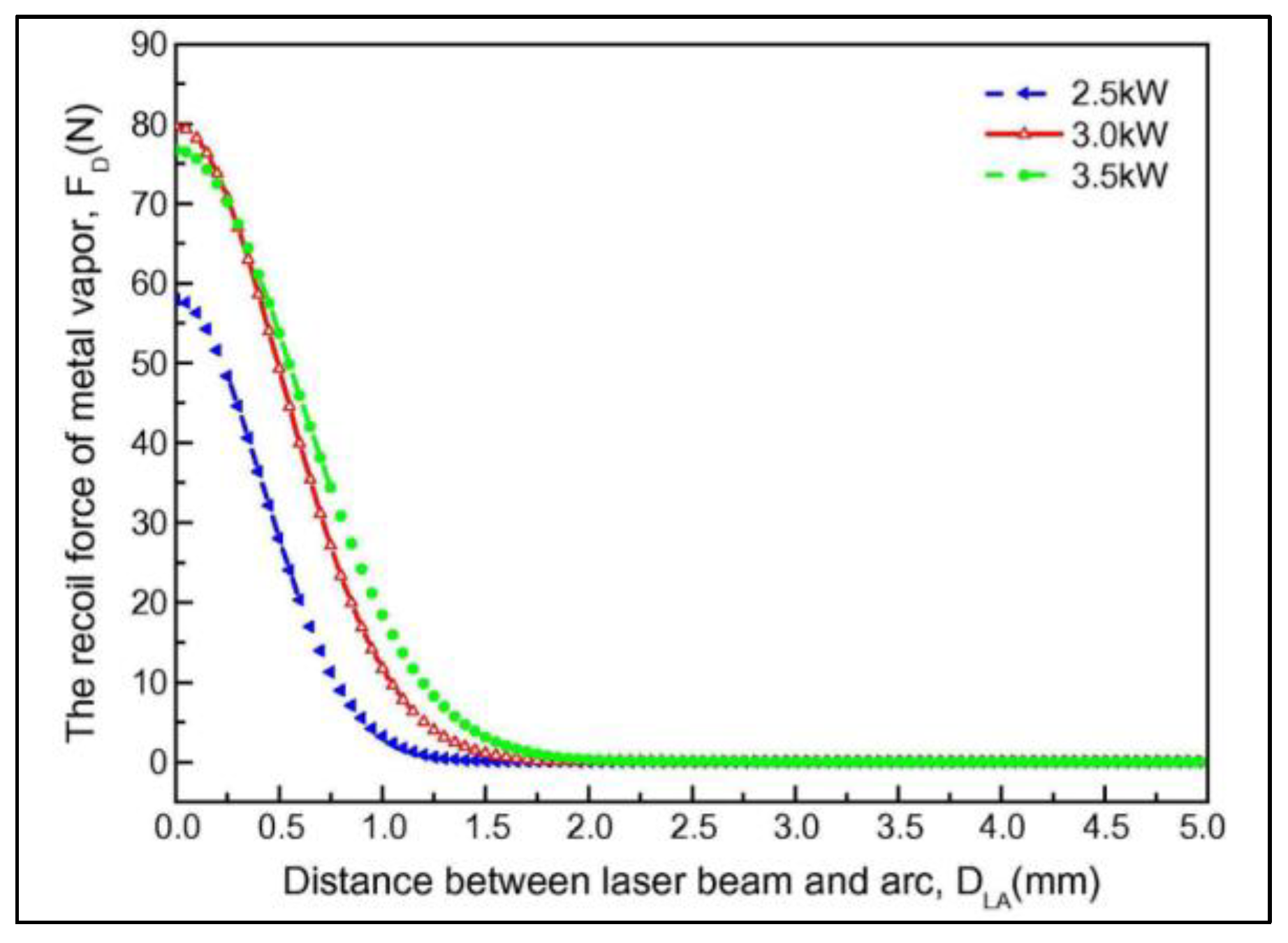
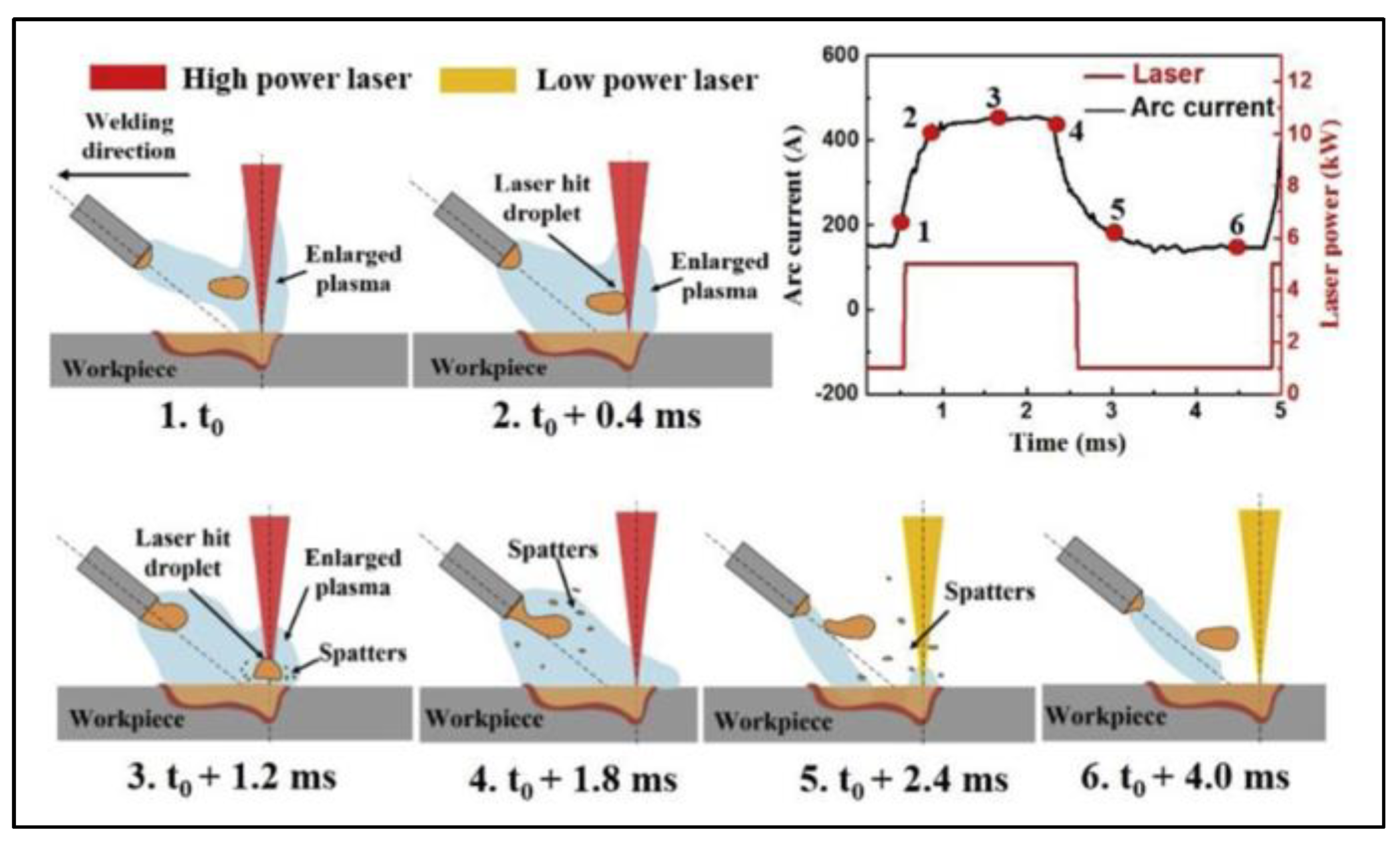
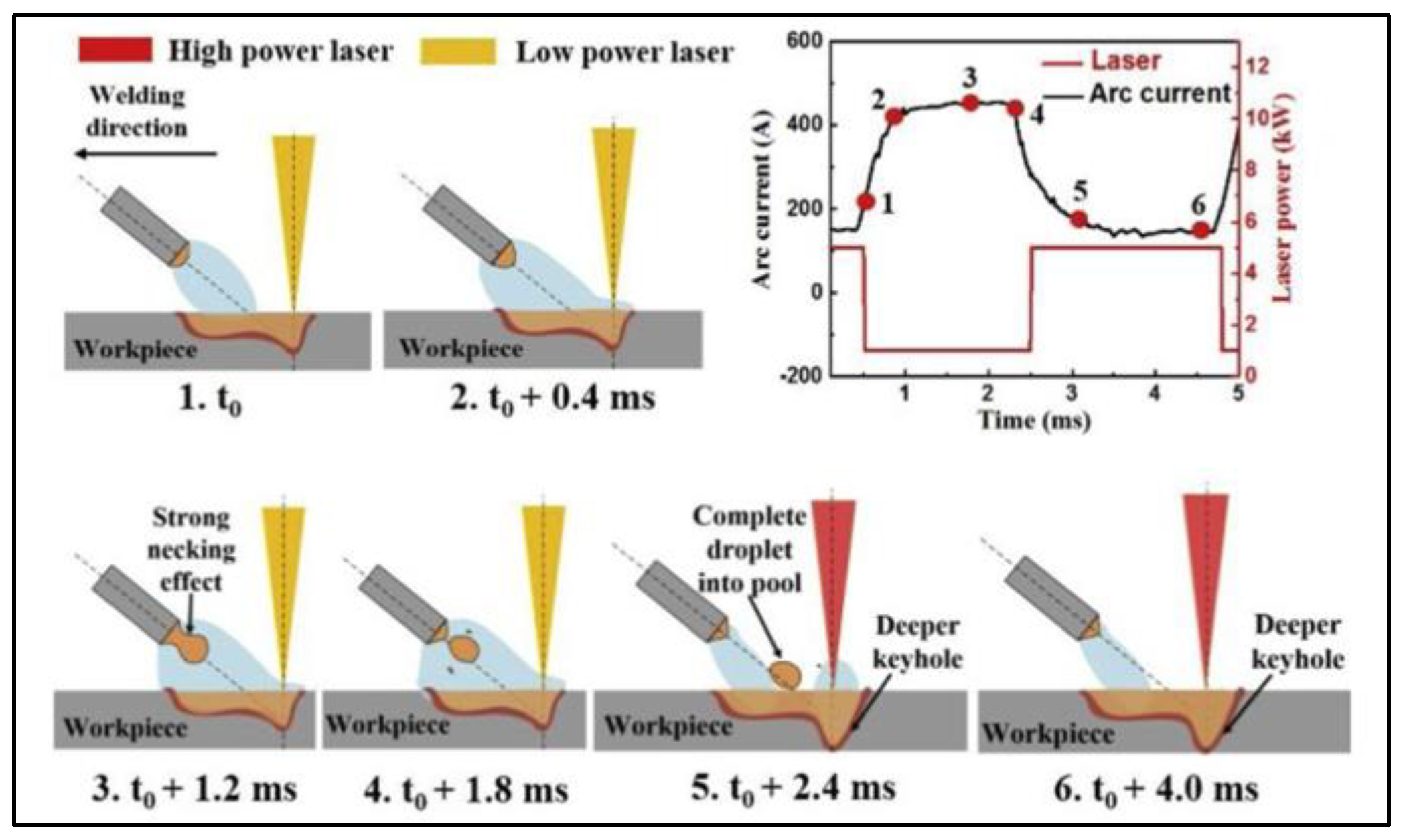
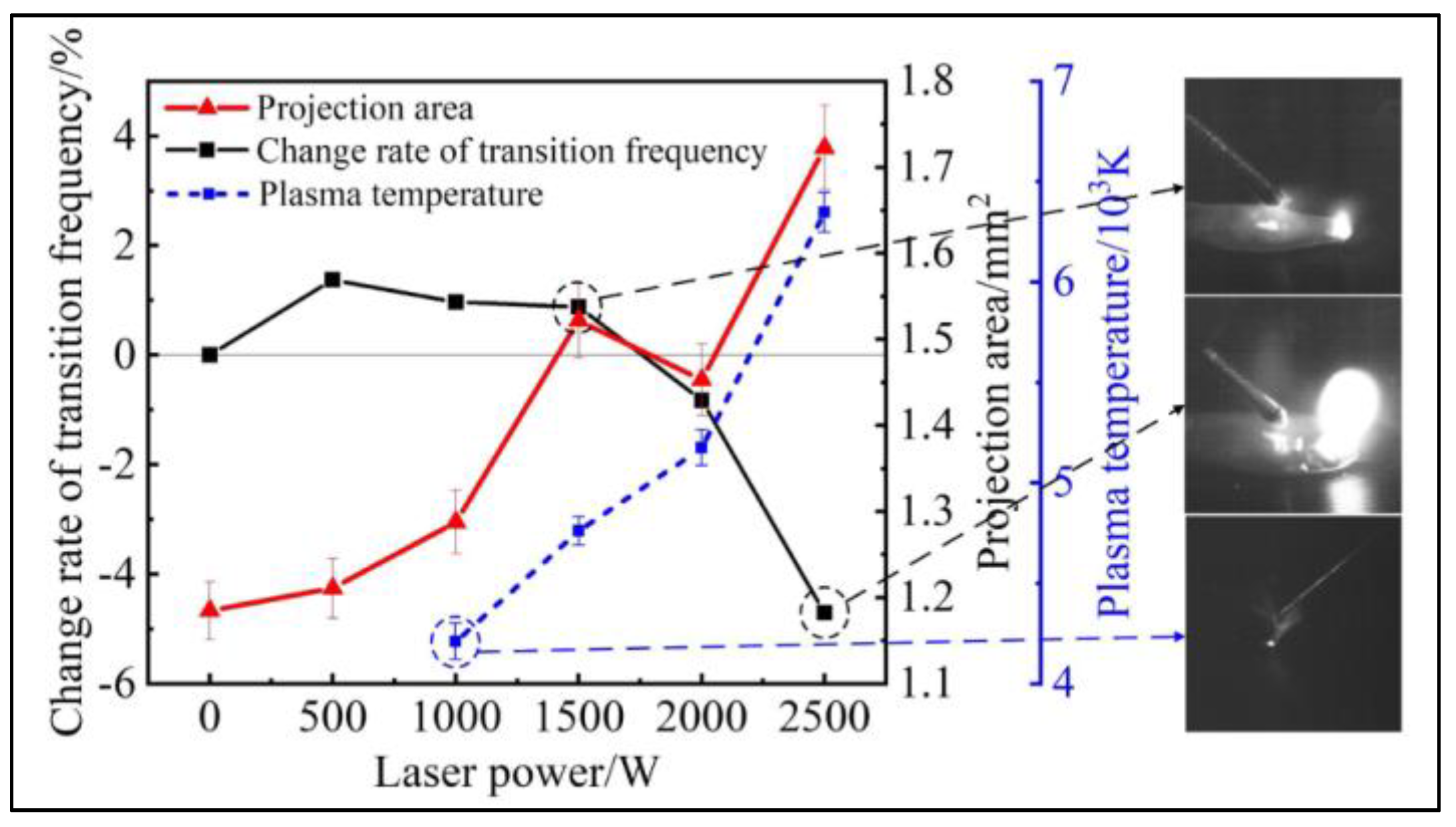
| Leading Mode | Materials | Advantages | Author | Year/Ref. |
|---|---|---|---|---|
| Laser-leading | Al alloy | better penetration depth | Casalino | 2013/[68] |
| 5053 Al alloy | low porosity and good weld formation | Huang | 2017/[69] | |
| - | stable welding process | Zhang | 2014/[70] | |
| A7N01 Al alloy | bright and clear weld morphology | Miao | 2017/[71] | |
| High strength steel | better weld quality | Cao | 2011/[72] | |
| SM490A steel | improving uniformity of weld metal | Zhao | 2009/[73] | |
| Arc-leading | High strength steel | superior weld geometry and grain size | Liu | 2016/[74] |
| Q235 steel | stable molten pool flow | Li | 2022/[75] | |
| 10CrNi3MoV steel | good weld morphology | Zhang | 2020/[60] |
| No. | Laser Power | Materials | Year/Ref. | Conclusion |
|---|---|---|---|---|
| 1 | 2 kW | Ti-6Al-4V | 2019/[105] | The blocking effect continued to increase as laser power increased. |
| 2 | 3 kW | High strength steel | 2018/[106] | |
| 3 | 3.5–5.5 kW | Stainless steel | 2012/[57] | |
| 4 | 1.5–3.5 kW | High strength steel | 2013/[77] | |
| 5 | 6 kW | E36 | 2013/[107] |
Disclaimer/Publisher’s Note: The statements, opinions and data contained in all publications are solely those of the individual author(s) and contributor(s) and not of MDPI and/or the editor(s). MDPI and/or the editor(s) disclaim responsibility for any injury to people or property resulting from any ideas, methods, instructions or products referred to in the content. |
© 2023 by the authors. Licensee MDPI, Basel, Switzerland. This article is an open access article distributed under the terms and conditions of the Creative Commons Attribution (CC BY) license (https://creativecommons.org/licenses/by/4.0/).
Share and Cite
Liu, Q.; Wu, D.; Wang, Q.; Zhang, P.; Yan, H.; Sun, T.; Zeng, J.; Yan, M.; Liu, Z.; Li, R. Research Status of Stability in Dynamic Process of Laser-Arc Hybrid Welding Based on Droplet Transfer Behavior: A Review. Coatings 2023, 13, 205. https://doi.org/10.3390/coatings13010205
Liu Q, Wu D, Wang Q, Zhang P, Yan H, Sun T, Zeng J, Yan M, Liu Z, Li R. Research Status of Stability in Dynamic Process of Laser-Arc Hybrid Welding Based on Droplet Transfer Behavior: A Review. Coatings. 2023; 13(1):205. https://doi.org/10.3390/coatings13010205
Chicago/Turabian StyleLiu, Qingyong, Di Wu, Qingzhao Wang, Peilei Zhang, Hua Yan, Tianzhu Sun, Jie Zeng, Mingliang Yan, Zhenyu Liu, and Ruifeng Li. 2023. "Research Status of Stability in Dynamic Process of Laser-Arc Hybrid Welding Based on Droplet Transfer Behavior: A Review" Coatings 13, no. 1: 205. https://doi.org/10.3390/coatings13010205
APA StyleLiu, Q., Wu, D., Wang, Q., Zhang, P., Yan, H., Sun, T., Zeng, J., Yan, M., Liu, Z., & Li, R. (2023). Research Status of Stability in Dynamic Process of Laser-Arc Hybrid Welding Based on Droplet Transfer Behavior: A Review. Coatings, 13(1), 205. https://doi.org/10.3390/coatings13010205








